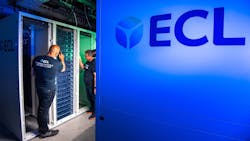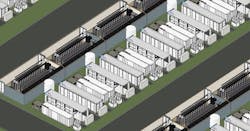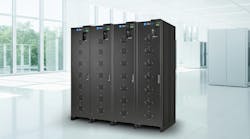ECL Debuts 1 GW Off-Grid Hydrogen-Powered 'AI Factory' Data Center On 600 Acres Near Houston
Last June, data center-as-a-service pioneer ECL unveiled what it proclaimed as "the world’s first off-grid, sustainable, modular, built-to-suit data center" in Mountain View, California. At that time, ECL heralded delivery of its first hydrogen-powered data center on a fully-leased basis, backed by its raising $10 million to support phased development.
The capital funding followed an initial round reported on by DCF in January 2023, when ECL announced $7 million in seed financing and revealed its plans to deploy hydrogen-powered modular data centers that are built using 3D printing and require no local power and water.
Backed by Molex and Hyperwise Ventures and headquartered in Mountain View, ECL takes as its mandate the delivery of off-grid, reliable, sustainable hydrogen-powered data centers-as-a-service. Led by CEO Yuval Bachar, the company’s founders are data center veterans of some of the most prominent companies in technology, including Facebook, Microsoft, LinkedIn, Cisco, HPE and Bloom Energy.
ECL's thusly launched MV1 facility in Mountain View was envisioned as a proof-of-concept colocation site where customers could experience hydrogen power. According to the company, ECL-MV1, now in full production, represents the world’s first off-grid, hydrogen-powered modular data center that operates 24/7 with zero emissions, minimal noise, and a negative water footprint, while replenishing water to the community.
Fully leased to AI hosting specialist Cato Digital (who is packing 1,800 GPUs into 22 racks, and running 1 MW of capacity in about 1,000 square feet) the facility is off-grid, with no utility power connection, and operates at a power usage effectiveness (PUE) under 1.1, comparable to the energy efficiency of the largest cloud data centers.
ECL uses rear-door heat exchangers to cool its racks, supporting power densities of 75 kW per cabinet. ECL also uses two cooling loops, one using water output from the hydrogen fuel cell, and a backup loop. Specifically, the company says the MV1 facility offers a 10x increase in energy efficiency with a PUE of 1.05 and a 7x improvement in data density per rack, which is ideal for AI high-density demands.
Industry veteran Bachar's plan has always been to deploy hundreds of megawatts of highly-sustainable data center capacity alongside hydrogen pipelines and solar power arrays. At a moment when demand for AI computing power is outpacing the supplies of data center capacity and renewable energy, Bachar believes ECL offers a unique sustainable option - i.e. repeatable modular data centers, powered by hydrogen and built using 3D printing technology.
ECL TerraSite-TX1
In a move to supersize its ambitions, last month ECL announced it is building what it calls "the first fully sustainable 1 gigawatt (GW) AI Factory data center."
Dubbed ECL TerraSite-TX1, as located on a 600-plus acre site east of Houston, ECL said the initial phase of TerraSite-TX1 will be delivered in the summer of 2025 at a cost of approximately $450 million, with 50 MW of data center capacity to be utilized by data center cloud and AI cloud operators. The entire 1 GW site will be constructed at a cost of approximately $8 billion, with funding to be provided by ECL and financial partners.
Bachar said, "We're building our first large-scale campus data center with an initial commitment for 1 GW, with an option to expand it to 2 GW. We are in business. We're taking orders and the first delivery of the data center is going to happen in phase one in the summer of next year, about 9 to 10 months from now."
Designed specifically for the development and deployment of artificial intelligence (AI) technologies -- hence the "AI factory" appellation -- the Houston site will provide space for tenants to deliver both AI cloud and traditional cloud services to customers.
Hydrogen will be provided by three separate pipelines that converge at the site, eliminating the need for additional fuel transportation. The site's initial 1 GW phased development stands to be expanded to 2 GW in the future, enabled by the design's modularity and based on customer demand.
Bachar said, "We are doing build-to-order, actually building exactly to a specific set of requirements by customers. We have significant level of customer engagement at this point. We are over-subscribed on the site for sure, for what we can actually deliver, versus what the demand is. But I guess every data center in the United States right now is over-subscribed. What makes us unique is it's the first data center in the world that will be at scale-zero emissions and zero water use."
First Tenant Lambda Eyes High Density for Maximum Efficiency
According to a press release, Lambda will be the first tenant at ECL TerraSite-TX1. The 600-plus acres at the site will give Lambda and other AI leaders the space and power needed for the next wave of digital infrastructure innovation, with zero emissions.
“The data center technology committed to by ECL is truly transformative in the industry,” asserted Ken Patchett, VP Data Center Infrastructure, Lambda. “We believe ECL’s technology could unlock a powerful and eco-conscious foundation for AI advancement. This new infrastructure could give researchers and developers essential computational resources while drastically reducing the environmental impact of AI operations.”
ECL contends it provides highly-competitive data center total cost of ownership (TCO) and among the fastest time-to-market, along with unmatched flexibility in location, size, and density. The ECL data centers are modular, allowing for easy expansion in 1 MW increments, and are built to suit and delivered in less than 12 months, vs. the industry standard of 36 to 48.
Bachar clarified, "One unique thing is we're very dense. We don't measure by square feet, we measure by megawatts, which is more important than square feet. We build data centers on 1000 square feet per megawatt. So when we build a gigawatt of data centers, a million square feet is going to be eventually compared to about six to eight million square feet built the traditional way. That's significant for the sustainability because the structures are much, much smaller."
By eliminating the environmental impact associated with traditional data center development and utilization, ECL also gives AI consumers assurance that their use of AI is not expanding their carbon footprints. Additionally, the company notes that its AI infrastructure is enhanced by its advanced AI data center management system, ECL Lightning, which offers real-time monitoring and micro adjustment control over every aspect of data center operations, from power generation to rack cooling, providing comprehensive visibility and configuration capabilities, ensuring optimal performance for AI and other workloads.
3D Printing for a Premium Data Center
"This is the first site that we're doing 3D printing in," says Bachar. "Concrete 3D printing is pretty straightforward. We use recyclable concrete. We bring it on-site and we print very, very fast. That's part of the reason we can deliver the data center so quickly to our customers. It's the most sustainable construction model that we have right now in the construction industry because it has zero waste. There's nothing else coming out, no plates and no frames -- you don't need to any support materials or anything like that."
Bachar adds, "We are delivering a premium data center, but we're delivering it at a very competitive price compared to traditional data centers. Customers that come to us are not required to pay premium at this stage for getting a premium data center. We use analogy of giving you a Ferrari for a price of a Toyota -- for now. Part of our mission is to enable the market to actually accept off-grid solutions with high reliability."
"The best thing for us now is actually to give them a competitive price. We'll also have to go through qualification in Texas which has to be a Tier IV data center - a very high availability data center to six nines of availability. From that perspective, I think it gives our our customers a better feeling of not giving anything up on uptime because they're running off-grid and on hydrogen."
The Zero Water Play
ECL's proprietary cooling innovations include using water from hydrogen-based power generation, along with patent-pending quadruple loop and direct-to-chip cooling technologies for its extremely high-density racks. During our latest interview with ECL's Bachar, DCF's correspondent expressed a layperson's fascination with how a hydrogen data center site its cooled with water it generates itself.
Bachar said, "It's the fact that we said it uses zero water, right? Cooling data centers with water is much more efficient than cooling with air. We leverage rear door heat exchanger technology which is a combination of water and air. But we don't take water from the environment and as a result, we can actually leverage very high efficiency evaporative coolers, which most data centers can't use, because it's a tremendous amount of water that's required to run them - like millions of gallons per year."
He continued, "We are producing much more water than what we actually need. As a result, as a by-product to the energy generation, we give back water to the community. For instance in Mountain View, we'll give it back to the golf course next to us for irrigation, and so they won't have to do irrigation during the summer."
Bachar added, "There's one more cool thing about the water - literally cool. We cool the water in the locations where we have liquid hydrogen with the hydrogen. When we bring the hydrogen into our power generation system, in the process of actually boiling the liquid hydrogen, we capture the energy and we actually cool the data center for free, basically. That's how we can achieve the PUE that we're talking about of 1.1 or better."
A Community-Integrated Data Center
ECL Terrasite-TX1 comes at a critical time for the state of Texas, with The Electric Reliability Council of Texas (ERCOT) testifying on June 12 of this year that the state’s power grid needs will grow approximately 2x by 2030 due, in part to the growth of data centers and AI.
In response, Texas Lieutenant Governor Dan Patrick posted to X, “We want data centers, but it can’t be the Wild Wild West of data centers and crypto miners crashing our grid and turning the lights off.”
ECL says Terrasite-TX1 is purpose-built to eliminate the stress on the state’s power grid while facilitating state-level economic development and growth of the AI industry.
“While others talk about delivering off-grid, hydrogen-powered data centers in five, ten, or 20 years, only ECL is giving the AI industry the space, power, and peace of mind they and their customers need, now,” said Bachar. “The level of innovation that we have introduced to the market is unprecedented and will serve not only us and our customers but the entire data center industry for decades to come.”
Importantly, Bachar added, "We are what we call a community-integrated data center. We're working very closely with the rural community that we're going to put the data center next to in Texas. We're planning to participate in their education system at multiple levels from K - 12, bringing them special classes in AI and data center knowledge or in after-school programs, offering them an internship program for high-schoolers, and a training program post-high school."
"It's an important part of what we're doing. We met with the community; the community loves us. They want us to come in and it's a really good relationship. We are doing something which is very unique from the perspective of bringing all this economic development, education and community integration without requiring anything back from the community, which is pretty amazing. We just want to be a good neighbor because we believe that data centers are a part of our day-to-day life."
Plans for Europe
In the course of our interview with ECL's Bachar, DCF remarked on how TerraSite TX-1 is apparently an exemplary green campus, and wondered what the response from the European data center community has been.
Bachar said, "They are looking into what the US is doing right now. On one side, they are very structured in Europe. But because they're very structured, everything goes there a little bit slower, or in some cases very slow. A lot of government control, et cetera, which we don't have."
("It's not that we don't have government control," clarified Bachar. "We have less government control over here, especially in specific states. For instance, Texas is very, very receptive to businesses to come and actually do business.")
Bachar explained further, "Europe's economy of hydrogen is about six to 9 months to a year maybe behind the developments of hydrogen in the United States. But they're putting a lot of emphasis and a lot of money into the infrastructure, so they will catch up very quickly, in my opinion. And once this catch-up happens, it's going to run in parallel."
He noted, "The interesting thing is the same suppliers of hydrogen in the US are the suppliers in Europe - it's the same global companies who deliver hydrogen across the world. We expect them to see what's happening here and see the revenue that we generate for them, that we are a very large off-taker of hydrogen, and there's an opportunity over here. We'll take the whole thing to Europe in the same model."
Bachar concluded, "We're working very closely with them. We have a very strategic relationship with them with agreements signed with them for delivery globally, not just in the US. It's going to take some time to get it available, but there's one major pipeline which is going to run from Morocco all the way to Sweden, and we'll try to attach ourselves to that pipeline once it's available."
About the Author
Matt Vincent
A B2B technology journalist and editor with more than two decades of experience, Matt Vincent is Editor in Chief of Data Center Frontier.




